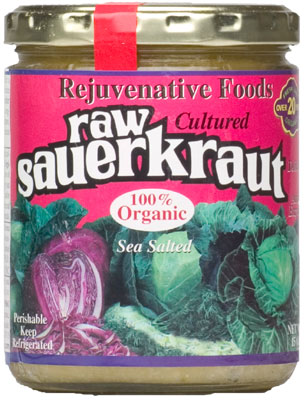Traditional food preparation meant fermenting and therefore preserving foods with salt, encouraging lactofermentation. The result of culturing vegetables in this way (think sauerkraut) is the beneficial probiotics and enzymes produced by the bacteria during fermentation, and they last a long time! Cultured vegetables are easy to make and have myriad health benefits.
Repairing and maintaining digestion is the heart of my work as a nutritionist. Cultured veggies are one of the top foods that help foster proper gut ecology, which essentially means you’re maintaining the proper ratio between good and bad bacteria in your intestinal tract. Too much bad bacteria means candida, dysbiosis, bloating, constipation, weight gain, cravings, even acne.
Cultured Vegetables: Benefits
Raw, cultured vegetables have been around for thousands of years, but you may know them as sauerkraut. Over here in the holistic health community, we don’t refer to them as the same krauts like you’d find in the supermarket, because those have been heated and pasteurized and contain chemical preservatives (sodium benzoate, anyone?). The pasteurization (heating) process destroys precious enzymes.
Cultured veggies are made by fermenting vegetables of your choice (my faves are cabbage, ginger, beets, and carrots) in stainless steel. The fermentation process produces tons of probiotics and beneficial enzymes, good for digestion. Eating them makes me feel so good and healthy.
Here are some benefits of raw, cultured vegetables
- improved digestion
- increased longevity via improved detoxification, better immunity, cell rejuvenation due to natural enzymes
- help control cravings
- help the body maintain alkalinity (remember acidoisis = degeneration)
- tons of probiotics
How to Eat Cultured Vegetables
Eat 1/4 – 1/2 cup with every meal. They are slightly tart, which complements meat and veggie dishes very well. Eat more if you’ve undergone a recent round of antibiotics or if you take hormonal birth control, both of which upset your good gut bacteria. Cultured veggies help you digest meat proteins. When eaten every day, you should notice an improvement in regularity. They contain more probiotics than yogurt and can be enjoyed by those avoiding dairy!
Here is a recipe I have on file from the Body Ecology book. Be creative with your veggies. Enjoy.
Version 1
3 heads green cabbage, shredded in a food processor
1 bunch kale, chopped by hand
(optional): 2 cups wakame ocean vegetables (measured after soaking), drained, spine removed, and chopped
1 Tbsp. dill seed
Version 2
3 heads green cabbage, shredded in a food processor
6 carrots, large, shredded in a food processor
3 inch piece ginger, peeled and chopped
6 cloves garlic, peeled and chopped
Cultured Vegetables: Recipes
I recommend using the kraut source fermentation device! Read all about it here + my fermented watermelon rind recipe.
1. Combine all ingredients in a large bowl.
2. Remove several cups of this mixture and put into a blender.
3. Add enough filtered water to make a “brine” the consistency of a thick juice. Blend well and then add brine back into first mixture. Stir well.
4. Pack mixture down into a 1½ quart glass or stainless steel container. Use your fist, a wooden dowel, or a potato masher to pack veggies tightly.
5. Fill container almost full, but leave about 2 inches of room at the top for veggies to expand.
6. Roll up several cabbage leaves into a tight “log” and place them on top to fill the remaining 2 inch space. Clamp jar closed.
7. Let veggies sit at about a 70 degree room temperature for at least three days. A week is even better.

Mary Vance is a Certified Nutrition Consultant and author specializing in digestive health. She combines a science-based approach with natural therapies to rebalance the body. In addition to her 1:1 coaching, she offers courses to help you heal your gut and improve your health. Mary lives in San Francisco and Lake Tahoe in Northern California. Read more about her coaching practice here and her background here.





